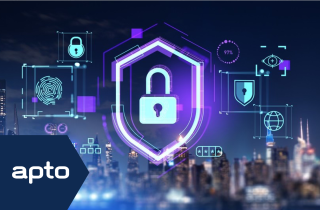
As increasing interconnectivity and reliance on technology amplify potential cyber risks, robust threat management is difficult, but also essential. With a centralised vantage point over logs and event data from various devices, applications, and platforms within your network, SIEM solutions underpin effective modern threat management and are key enablers for proactive solutions. This article explores threat management and the pivotal role of SIEM tools in empowering cyber risk mitigation.
What is Threat Management?
Threat management is the systematic process of identifying, assessing, and prioritising potential cyber threats to an organisation’s critical assets, services, and data. With the expansion of most companies’ digital footprints, cyber attack surfaces are larger than ever. Exemplifying the rapid growth, a 2023 report found that the number of cyber assets at surveyed companies increased by 133 per cent over the previous 12 months.
This larger attack surface necessitates a holistic approach to make sure that you don’t only detect threats but you can also evaluate them in terms of their potential impact for timely and effective mitigation. In other words, you need to know what threats matter, how they might affect your business, and what to do about them.
There are four central components to threat management:
- Threat intelligence: The collection and analysis of information about potential threats. This includes identifying emerging vulnerabilities, understanding threat actors, and staying updated on the latest attack methods.
- Risk assessment: Systematically evaluating the potential risks that may result from cyber threats. Risk assessments consider both the likelihood of a threat occurring and the impact it would have on your business.
- Threat modelling: Creating representations of potential attack vectors and understanding how threat actors might exploit vulnerabilities in systems and applications.
- Countermeasures and response strategies: Developing and implementing proactive and reactive measures to prevent, mitigate, or respond to identified threats. This component of threat management increases resilience against potential cyber-attacks.
Fast Changing Environment
The cyber threat landscape continues to evolve swiftly. As an example, take ransomware. A few years ago, ransomware attacks simply meant malicious software installed on multiple systems that encrypted those systems and the data on them. Now, ransomware often means triple extortion attacks involving standard ransomware installation, data theft, and DDoS components that overwhelm networks or systems with large volumes of bot traffic.
In this fast-changing landscape, cyber threat management provides organisations with proactive tools and strategies to anticipate, detect, and respond to new and emerging threats. By continuously assessing risks and adjusting defences accordingly, proper threat management ensures your company’s security posture remains robust and resilient. Furthermore, by swiftly addressing and mitigating threats, cyber threat management helps maintain business continuity,
SIEM and Threat Management
SIEM, or Security Information and Event Management, is a solution that offers real-time analysis of data emanating from your company’s network, hardware, and software infrastructure. A well-functioning SIEM collects relevant event data from diverse sources, normalises this data to ensure consistency, correlates events to detect patterns, alerts your security teams about potential threats, and uses dashboards and reports to provide visual insights and facilitate informed decision-making.
In relation to threat management, SIEM solutions offer the following benefits:
- Real-time threat detection—SIEM systems constantly monitor and analyze the flow of data across your infrastructure. By doing so, they can immediately identify suspicious activities or deviations from established patterns to provide a real-time overview of potential threats. This instant detection is crucial in a landscape where timely identification is often the difference between a minor issue and a major breach.
- Improved incident response times—With the instant alerts and comprehensive insights provided by SIEM, security teams can quickly pinpoint the nature and location of a security event. This accelerates decision-making processes and allows for more rapid containment and remediation to minimise the potential damage. In one case study, using a specific SIEM tool reduced incident response times by 90 per cent.
- More robust threat assessment—SIEM systems leverage advanced analytics algorithms to sift through vast amounts of data. This not only helps in detecting known threats but also uncovers novel threat patterns or zero-day vulnerabilities. The analytical capabilities of SIEM enhance the depth and breadth of threat assessments to help you better understand the ever-evolving cyber threat landscape.
Managing Risk with SIEM
Risk registers
A risk register is a risk management tool used to document, keep tabs on, and prioritise the cyber risks faced by your specific company and the various threat pathways that cyber criminals could use to realise these risks. This register uses company-specific data like risk likelihood, impact, and mitigation options. Companies that use a risk register often initially maintain one as a spreadsheet file, but as their cyber maturity grows, they might migrate their risk register to more specialised risk management tools or platforms.
When SIEM systems integrate with risk registers, a powerful synergy emerges. The SIEM continuously ingests and correlates live data by cross-referencing against the known risks catalogued in your risk register. This integration ensures that any observed anomalies or suspicious patterns are evaluated in the context of your company’s predefined risk landscape. By doing so, SIEM can provide more informed, prioritised alerts and give a centralised view of both real-time threats and potential vulnerabilities.
Some businesses opt for frameworks like the NIST Cybersecurity Framework (NIST CSF) to serve as benchmarks for standardising risk assessments. While this approach is helpful, frameworks don’t account for the fact that every organisation has its unique mix of assets, threats, and vulnerabilities. A risk register is what truly captures company-specific risks and gets the most from your SIEM tool.
Risk modelling and threat intelligence
SIEM systems are adept at ingesting and analyzing vast amounts of data from your company’s various digital touchpoints, such as network traffic, server logs, application logs, and more. SIEM tools process this data to discern patterns, anomalies, and behaviours that might indicate potential threats or malicious activities.
Advanced algorithms and analytics within the SIEM facilitate the creation of threat models to help simulate scenarios in which vulnerabilities might be exploited. This threat modelling facilitates proactive detection and response.
To stay ahead of today’s dynamic threat landscape, SIEM tools can also integrate with threat intelligence feeds. These feeds provide real-time information on emerging threats, vulnerabilities, and malicious tactics, techniques, and procedures (TTPs) identified worldwide. By leveraging these feeds, SIEM systems can continuously update their detection mechanisms so that they can spot emerging threats.
Crafting Detection Use Cases with SIEM
Detection use cases in SIEM tools are specific scenarios or patterns of activity that you pre-configure or custom tweak your SIEM solution to detect. By defining relevant use cases, you can tailor your company’s SIEM systems to proactively monitor and alert on particular behaviours or events indicative of potential security threats or breaches.
The process of creating SIEM detection use cases begins with identifying risks, usually sourced from a risk register, which details and categorises the key vulnerabilities and threats your company might face. After pinpointing key risks, you model potential threats to simulate how adversaries might exploit them in real-world scenarios.
Lastly, you then design specific alerts and triggers within the SIEM system. Calibrating the alerts detects the patterns and behaviours identified in the threat models to ensure that if those activities occur in your IT environment, the SIEM system promptly and accurately raises the alarm for your teams to investigate.
The benefits of these tailored detection use cases include more accurate threat detection, reduced false positives (one recent survey found that 20 per cent of security alerts are false positives), and customised security measures that reflect business-specific needs and risks.
Conclusion
To wrap up, SIEM plays an indispensable role in modern threat management by offering real-time insights and proactive defences. As cyber threats evolve, it’s vital to constantly learn and adapt your approach to threat management based on evolving, company-specific risks and stay one step ahead of threat actors.
Don’t wait for a breach to underscore gaps in your security. Consider implementing or fine-tuning SIEM tools in your organisation. By embracing SIEM’s comprehensive capabilities, you can craft a more effective, proactive and resilient cybersecurity strategy.
-

24 April 2025
SIEM Migration Trends
-

18 April 2025
Key Differentiators: What an MSSP Will and Won’t Do
-

15 April 2025
The Operating Model
See how we can build your digital capability,
call us on +44(0)845 226 3351 or send us an email…
